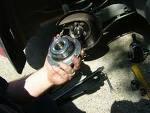 There are a number of things that will help you to know when the hub bearing in your vehicle has a problem. If the car seems to shake from below as you drive, for instance, then the car should be checked without delay.
There are a number of things that will help you to know when the hub bearing in your vehicle has a problem. If the car seems to shake from below as you drive, for instance, then the car should be checked without delay.
You need to make some preliminary checks because such vibrations do not necessarily indicate a hub bearing problem. Find out what the problem really is first of all. Stop the car and check the wheels.
Park the car on level ground, lift it with a jack and then move the wheel with your hand. If you hear some noise or find it difficult to move the wheel, then you are probably having hub bearing problems.
If you have installed an ABS sensor, then it can let you know when the hub bearing has a fault.
- Check the car whenever the sensor detects some problem in the hub assembly. Hub bearing problems can lead to steering difficulties or detachment of the wheel.
- Check whether the hub is warm after you have traveled for ten miles. The hub assembly helps in preventing friction and you should replace it if you notice the development of heat.
- Check the hub bearing frequently if you drive a lot.
It is important that you change the hub bearing whenever you notice the development of problems to avoid further complications.
Fixing a Hub Bearing
Although fixing a hub bearing can be quite tricky, you can never the less carry it out on your own. If you fix the hub bearing at home, you will make significant savings as you will not need to pay labor expenses. The hub bearing helps to align the wheel and the axle, which will also be able to turn together. The bearing joins the hub shell and the axle. There comes a time when you finally need to replace the hub bearing.
In order to do this, you will need wheel chocks, jack, set of sockets, set of wrenches, spindle nut socket, flathead screwdriver, torque wrench, hammer, and sand paper. Then take the following steps.
- Remove the wheel
- Park the vehicle on a flat surface, engage the parking brake, and place wheel chocks on the rear wheels. Loosen the lug nuts before raising the vehicle with the jack. Then remove them and the wheel after raising the car.
- Detach the caliper
- Two slider bolts are usually used to hold the caliper, which you need to remove. Use a bungee cord to support the caliper, which will be hanging.
- Detach the rotor
- You may need to remove the brake pads, in which case you should preferably take pictures that will help you during installation. Then you need to detach the rotor to give you access to the spindle nut, which you also need to remove.
- Fix the bearing.
- Remove the bolts of the wheel bearing assembly and fix the slider hammer on the studs. Take care as you remove the bearing so that you will be able to reinstall easily and prevent possible injuries.
- Clean the knuckle using sand paper and then install everything in reverse order. Use the pictures you took to make sure its same as it was.
So to Recap:
You will need a torque wrench if you would like to change the hub bearing. Remove the wheel, brakes, as well as the hub nut. You may have to remove the brake pads too depending on your type of vehicle.
Use a big rubber mallet to remove the rotor, but do not apply too much force. Repeat the process until the rotor comes off. If ABS wires are attached, then you will need to remove them. Replace the rotors and then reassemble everything.
Read more at Suite101:
How to Pinpoint Common Hub Bearing Problems http://www.suite101.com/content/how-to-pinpoint-common-hub-bearing-problems-a349206#ixzz1EJ9HPqaw




![Top 20 Used Cars to Avoid Buying in Kenya – [PHOTOS]](../../../blog/wp-content/uploads/2013/11/top-used-unreliable-cars-to-avoid2-80x60.jpg)
![Top 20 Used Cars to Avoid Buying in Kenya – [PHOTOS]](../../../blog/wp-content/uploads/2013/11/top-used-unreliable-cars-to-avoid2-100x70.jpg)




